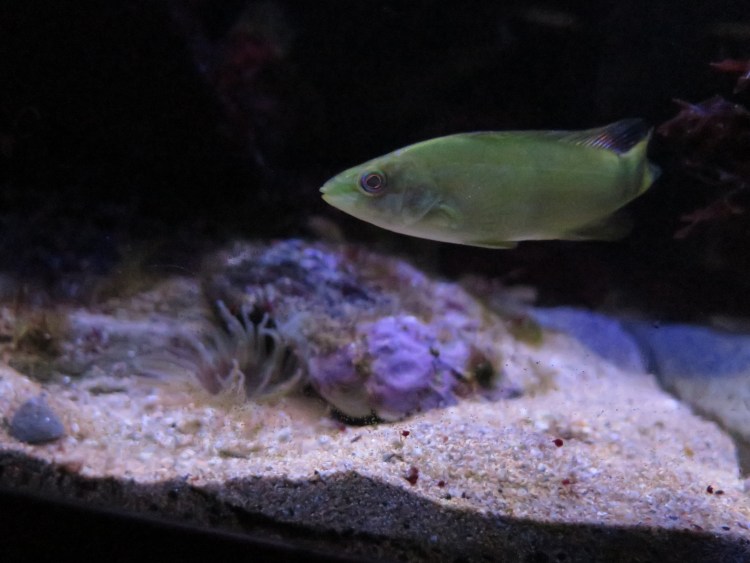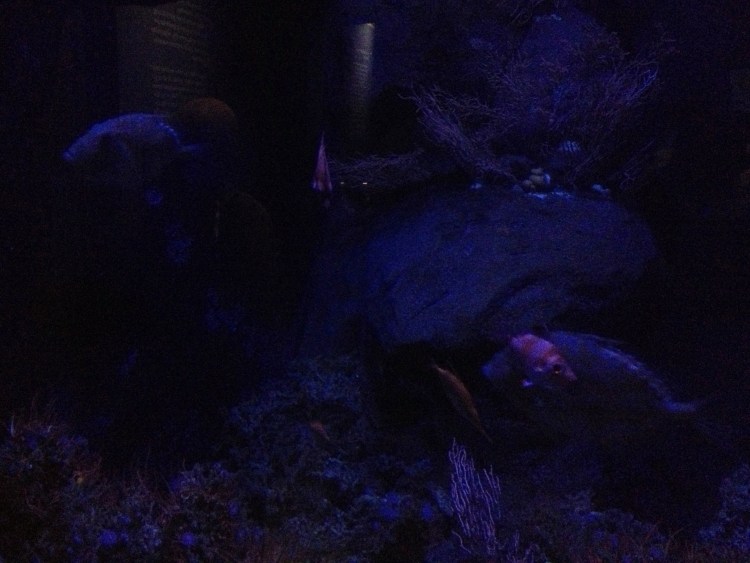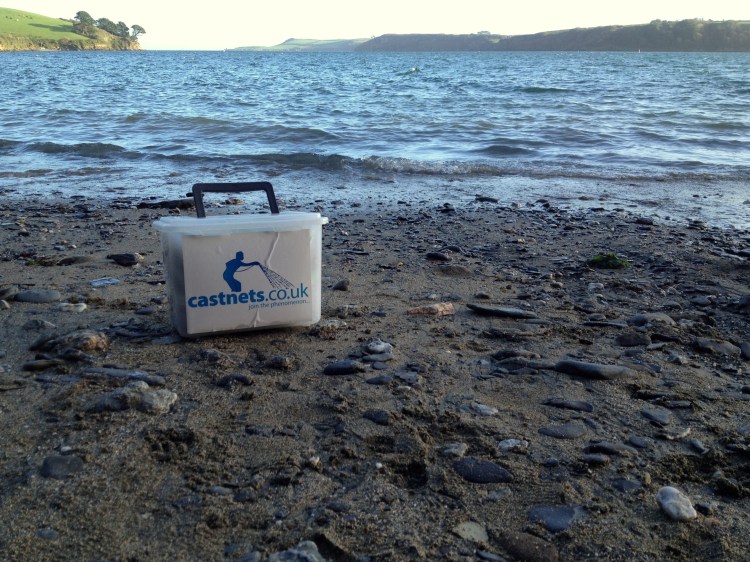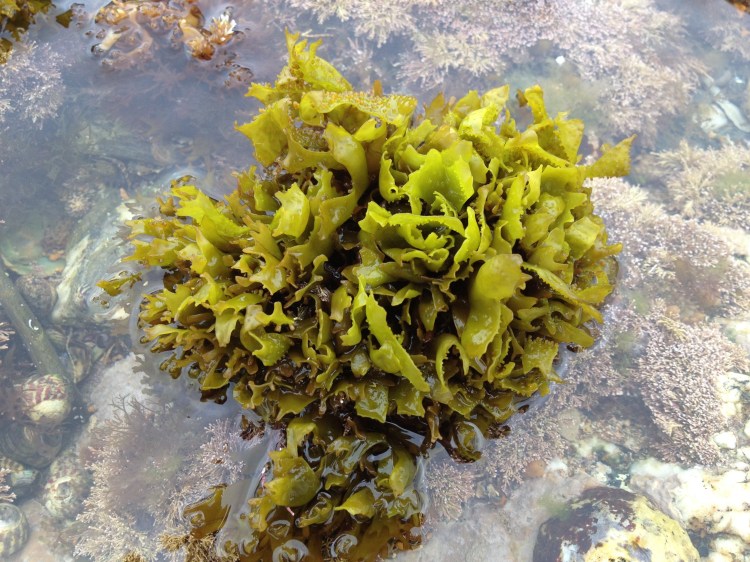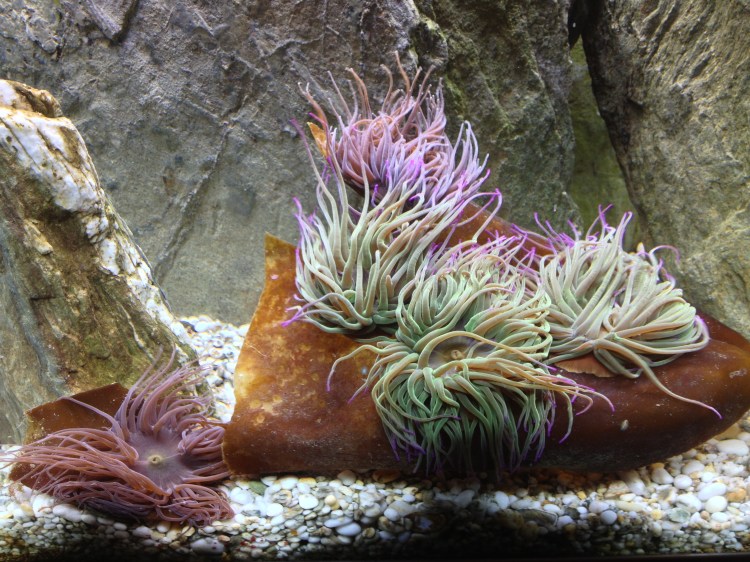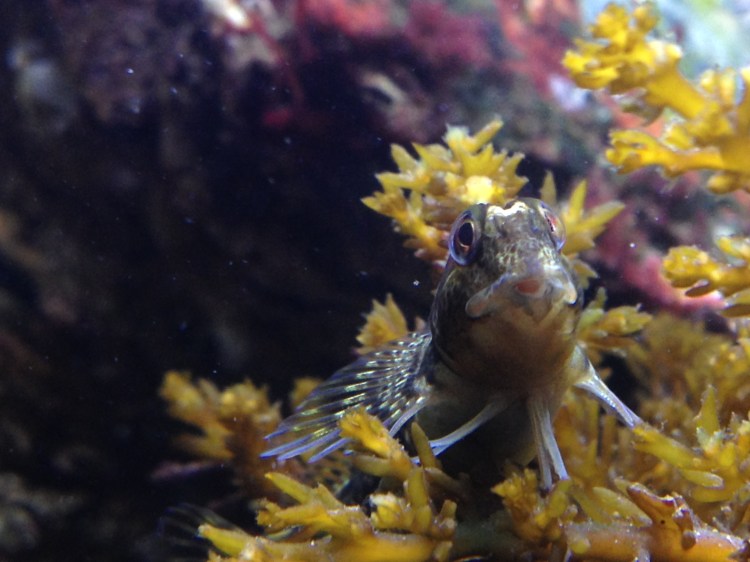It has been more than five months since the last update on my Red Sea Max 130D so high time for nr 16. I have bought a media basket to force the water more through the filtration material, which cannot be a bad thing, but otherwise have done very little. I have not been diving as much as I wanted, and still have not gone to any of the deeper sites where I perhaps could have found some Dahlia anemones, larger Brittlestars or other interesting things. I have a red seaweed growing from the rocks; it has encrusted all rocks in a deep red colour and grows out of in a bit of a lettuce-shape. At first I thought it was the invasive species Grateloupia but the shape and colour are a bit different, I will enquire at the Seaweeds of the NE Atlantic facebook group what it is. I have some green algae but they grow in tufts that can be easily removed so I cannot complain really. Below a shot of the tank, it does not look great but there you have it: The anemones are still so-so. I think that plumose anemones need very fines foods and water changes, which I do not really do and as a result they are often closed and not growing. The strawberries and beadlets still don’t do as well as they did, no idea why. My Red-speckled anemones (Anthopleura ballii) on the other hand do great and are my favourites. Below a photo of a specimen I collected at a good low tide in Flushing this week and one in my aquarium that has grown quite a bit. It fluoresces in the middle.
The anemones are still so-so. I think that plumose anemones need very fines foods and water changes, which I do not really do and as a result they are often closed and not growing. The strawberries and beadlets still don’t do as well as they did, no idea why. My Red-speckled anemones (Anthopleura ballii) on the other hand do great and are my favourites. Below a photo of a specimen I collected at a good low tide in Flushing this week and one in my aquarium that has grown quite a bit. It fluoresces in the middle. 
 I have some squat lobsters rummaging around as well as a cool hairy crab. I have got rid of prawns as they are so aggressive! Every time I opened the hood and stopped the pump, they came swimming to the top, legs tickling and scraping on the plastic and attacking my fingers. They are part of the reason that my fish have not fared too well. I had some Pollack for a while but they eventually succumbed. I believe my flow is on the strong side, and with an occasional missed feeding and less energy, the prawns and anemones will not tolerate any slip up! I caught some Sand smelt (see here for two videos) with my big net from the quay but these formed a meal for other inhabitants within the day. I caught a Topknot (by hand) (see here) but that disappeared after a while too. I have two or three Cornish suckers that do well though. As soon as I feed they stick their noses from under rocks and dart out to catch some defrosted shrimp but otherwise you hardly see them. I was lucky to catch a bright green juvenile Ballan wrasse Labrus bergylta of the quay which does great (they are not as nervous as the more common corkwing wrasse). I caught another individual (I only ever caught three) but the first one started picking on it, changing from bright green to a more subdued marbled green. I was not in time to release one of them and the second fish died unfortunately.
I have some squat lobsters rummaging around as well as a cool hairy crab. I have got rid of prawns as they are so aggressive! Every time I opened the hood and stopped the pump, they came swimming to the top, legs tickling and scraping on the plastic and attacking my fingers. They are part of the reason that my fish have not fared too well. I had some Pollack for a while but they eventually succumbed. I believe my flow is on the strong side, and with an occasional missed feeding and less energy, the prawns and anemones will not tolerate any slip up! I caught some Sand smelt (see here for two videos) with my big net from the quay but these formed a meal for other inhabitants within the day. I caught a Topknot (by hand) (see here) but that disappeared after a while too. I have two or three Cornish suckers that do well though. As soon as I feed they stick their noses from under rocks and dart out to catch some defrosted shrimp but otherwise you hardly see them. I was lucky to catch a bright green juvenile Ballan wrasse Labrus bergylta of the quay which does great (they are not as nervous as the more common corkwing wrasse). I caught another individual (I only ever caught three) but the first one started picking on it, changing from bright green to a more subdued marbled green. I was not in time to release one of them and the second fish died unfortunately.
Category Archives: Red Sea Max 130D
Aquarium Update 6
Time for a quick update on the aquarium. I could not resist trying to see how a school of mullet would fare with the sea scorpion around. Actually, the prawns formed a bigger immediate danger: one fish was grabbed and killed straight away, another fish I could save just in time, so I decided to remove the bigger prawns from the tank. The Sea scorpion picked off a bunch of the mullet in the first night and a couple in the week after but the number has stabilized at eleven, natural selection in action! Also added two Strawberry anemones. The Chrysymenia seaweed is growing very well and I have had to remove quite a bit already so it is forming a good nutrient sink. I have added more Cushion stars and Grey topshells to keep the algae and detritus in check.
let there be light
All right, after a variety of issues, the LEDs and dimmer have been finally installed. Actually, only one of the two LED strings is now hooked up to the dimmer, as the other potentiometer caught fire when testing it out. Although RapidLed’s staff was very helpful responding to questions, it was a right pain to get this done and if you are thinking of starting a marine tank: go with a custom tank and buy off-the-shelf LEDs and do not bother with a ‘plug-and-play‘ aquarium with fluorescent bulbs or a LED retrofit kit! (I will post a list of recommendations based on my own experiences for starting a native tank some time …)
 Anyway, it is all done now; one dimmable string with 12 white LEDs and one with 9 (if I remember correctly) white ones + 6 Royal Blues. The LEDs should have worked with the inbuilt timer but (at the moment) they don’t. This also means that the four inbuilt blue (moonlight) LEDs do not work at night, which is a shame. A very nice shimmer in the water; quite blueish, but I hope to get a replacement potentiometer soon so I can play around with the colour.
Anyway, it is all done now; one dimmable string with 12 white LEDs and one with 9 (if I remember correctly) white ones + 6 Royal Blues. The LEDs should have worked with the inbuilt timer but (at the moment) they don’t. This also means that the four inbuilt blue (moonlight) LEDs do not work at night, which is a shame. A very nice shimmer in the water; quite blueish, but I hope to get a replacement potentiometer soon so I can play around with the colour.
 I have put in sand instead of gravel which looks nicer. I have put in some Wireweed to provide some competition for algae now the light are back on (I could not resist sticking in some red seaweeds I found). Some cushion starts and topshells were left, but with the chiller and LEDs in place it is time to get properly get back to collecting animals and seaweeds. Marius has raised the bar pretty high on his Irish Rockpool Aquarium blog, so let’s see how it goes!
I have put in sand instead of gravel which looks nicer. I have put in some Wireweed to provide some competition for algae now the light are back on (I could not resist sticking in some red seaweeds I found). Some cushion starts and topshells were left, but with the chiller and LEDs in place it is time to get properly get back to collecting animals and seaweeds. Marius has raised the bar pretty high on his Irish Rockpool Aquarium blog, so let’s see how it goes!
Chiller
After a year and a half of running a supposedly cold water aquarium at room temperature (usually above 20C), I have finally bought a chiller! I found it very hard to choose between the several available brands, with mixed messages on forums about noise, ventilation and size. In the end I decided on a D-D DC300 chiller; however, the supplier was out of stock and suggested to take the 750 Watt model instead. As it was not that much more expensive and as running a larger chiller at shorter intervals is more econonomical (and also after a year of indecision I of course could not just wait for a couple of extra weeks), the D-D DC750 chiller it was. I ordered an Eheim compact +2000 pump (1000 to 2000 l/hr) to go with it online and got some insulated tubing from my local stoner hydroponics guy. When the chiller arrived it was a lot bigger than I thought. I placed it in a kitchen cabinet out of sight, and hopefully hearing, and with help from friends drilled two holes in the wall to the living room, to lead the tubing up to the tank:
 (I still have to drill holes in the surface for the two electric cables.) The chiller is set at 17C, which results in about 14-15C in the aquarium. With a lower temperature setting, ‘tank sweating’ (condensation) occurs. So the temperature is still at the upper end of native tanks, but I think (hope) it might make the difference for some species of algae and some sublittoral species. The chiller only comes on about four times per 24 hours for a half hour and the noise is not too bad. The inside of the cabinet heats up quite a bit, but I think it should not be a problem. I had planned to fit the outflow through one of the two holes drilled in the back compartment for the two Red Sea Max pumps, but the tubing was too stiff/the compartment too small to make the angle. I have now just tie-wrapped the tube into the tank:
(I still have to drill holes in the surface for the two electric cables.) The chiller is set at 17C, which results in about 14-15C in the aquarium. With a lower temperature setting, ‘tank sweating’ (condensation) occurs. So the temperature is still at the upper end of native tanks, but I think (hope) it might make the difference for some species of algae and some sublittoral species. The chiller only comes on about four times per 24 hours for a half hour and the noise is not too bad. The inside of the cabinet heats up quite a bit, but I think it should not be a problem. I had planned to fit the outflow through one of the two holes drilled in the back compartment for the two Red Sea Max pumps, but the tubing was too stiff/the compartment too small to make the angle. I have now just tie-wrapped the tube into the tank:
 I still have to find a proper solution to close the two holes, as I do not want the water to be sucked into the back compartment that way (bypassing the filter/skimmer). I have set the pump at 2000 l/hr which (with the loss because of chiller and tubing) is still not very strong (the two RSM pumps had a combined 1100 l/hr). I might re-install one of the original pumps to get some extra flow directed at the water surface. Next project: finally installing my LEDs!
I still have to find a proper solution to close the two holes, as I do not want the water to be sucked into the back compartment that way (bypassing the filter/skimmer). I have set the pump at 2000 l/hr which (with the loss because of chiller and tubing) is still not very strong (the two RSM pumps had a combined 1100 l/hr). I might re-install one of the original pumps to get some extra flow directed at the water surface. Next project: finally installing my LEDs!
new year’s resolutions
It has been a while since I last posted about the aquarium, mainly because I had a problem with algae and did not like the look of the tank in general. Combined with being away for two weeks over the holiday season, I decided to remove the rocks and most animals from the tank. Only left are some snails, Cushion stars and a Spiny starfish (who seems to do fine except for being less brightly coloured than when I caught it). The snails made a good start and cleaned up a lot of algae but it was too little too late. Also, (non Spiny starfish-related) mortality was quite high. Of all snails, the periwinkles fared least well (as I had noticed on earlier occasions); the Grey top shells seemed to do best. A main problem is that the snails move out of the water and often die there. Grey top shells can be found in the intertidal but are also common in the subtidal and so might be more suitable for the aquarium.
Anyway, time for a fresh start in the new year. I have decided to buy a chiller (and pump), mainly so I can switch off the noisy hood fans, but also because a more natural temperature regime might help keeping some of the more difficult species (see eg here and here). I have trawled the internet to find recommendations for the least noisy chiller but to no avail. I will stick with a more expensive brand and hope for the best. I will also invest in LED lighting. LED lights give a nice shimmer effect, generate less heat, use less electricity, need less replacement and are more easily dimmable. I’ve found this interesting Red Sea Max 130D retrofit kit: I will need to buy a separate dimmer and probably will have to ask my local sparky for help fitting it in the hood but it seems like a good investment. I’d like to supplement white LEDs appropiate for shallow water with some blue ones so I’ll be able to get a deeper water feel as well. This week I saw an inspirational aquarium back in Blijdorp Zoo in Rotterdam: a deep water reef with gorgonians, many brittle stars, Boar fish (or Zulu fish) Capros aper, Snipe fish Macrorhamphosus scolopax and John Dory Zeus faber. A crap photo:
I will need to buy a separate dimmer and probably will have to ask my local sparky for help fitting it in the hood but it seems like a good investment. I’d like to supplement white LEDs appropiate for shallow water with some blue ones so I’ll be able to get a deeper water feel as well. This week I saw an inspirational aquarium back in Blijdorp Zoo in Rotterdam: a deep water reef with gorgonians, many brittle stars, Boar fish (or Zulu fish) Capros aper, Snipe fish Macrorhamphosus scolopax and John Dory Zeus faber. A crap photo:
However, I will go for a more brightly lit seaweed aquarium first. I will switch to finer gravel and reduce the amount of rocks to improve water flow. This time I will also focus more on fish. Marius has a great picture of a Two-spotted goby Gobiusculus flavescens in his Irish rock pool aquarium here and I definitely want to have a couple of these (I had a tiny one recently but it was eaten by one of the Snakelocks…). The other fish I definitely want to have is a bright green juvenile Ballan wrasse Labrus bergylta (although the other species are pretty too):
 Small wrasse can be caught using a hand net but I reckoned it would be easier using a cast net. After my first trial run with such a net in the Helford river a while back I am not so sure though: loads of leaves and twigs but no fish. Youtube has hundreds and hundreds of ‘how to throw a cast net’ videos but these all use slightly different techniques which sometimes involve a throw whilst holding the led line between the teeth… Anyway, I’ll have to practice!
Small wrasse can be caught using a hand net but I reckoned it would be easier using a cast net. After my first trial run with such a net in the Helford river a while back I am not so sure though: loads of leaves and twigs but no fish. Youtube has hundreds and hundreds of ‘how to throw a cast net’ videos but these all use slightly different techniques which sometimes involve a throw whilst holding the led line between the teeth… Anyway, I’ll have to practice!
seaweeds in the aquarium Part I
After some musing on animals that I had good- (here and here) or bad (here) experiences with during the past year-and-a-bit that I have my aquarium, I thought it would also be good to take stock of my experiences with seaweeds. Not many people have temperate marine aquariums, and only few of those who do seem to focus on seaweeds. That is understandable, because it is hard keeping seaweeds! I currently have almost no seaweeds in my tank, as I wanted a break from the problems I had with die backs and resulting detritus. Below a picture of my 130 liter aquarium at its prettiest (see this post); unfortunately it did not look that way for long (see this post): Although keeping seaweeds in the aquarium is difficult, they are so beautiful, diverse and abundant that it is definitely worthwhile to try. The range of shapes and colors is much greater than that of the vascular plants in freshwater tanks. Also, the fact that so few people seriously try to grow different seaweeds in their tank makes it an extra interesting challenge. My fellow aquarists reading this will agree that it is great to look at a ‘finished’ tank, but building it up and experimenting to ‘get it right’ is an integral part of the fun. Keeping a native tank means that you can collect yourself which is a great activity in itself (and free). being able to observe organisms in their own habitat also gives you some clues on how to best keep them in the aquarium. Anyway, below my personal- and somewhat disjointed thoughts on the topic of keeping seaweeds in the aquarium (with some links to previous posts). Quite a lot to write about so I’ll save some pondering for a part II.
Although keeping seaweeds in the aquarium is difficult, they are so beautiful, diverse and abundant that it is definitely worthwhile to try. The range of shapes and colors is much greater than that of the vascular plants in freshwater tanks. Also, the fact that so few people seriously try to grow different seaweeds in their tank makes it an extra interesting challenge. My fellow aquarists reading this will agree that it is great to look at a ‘finished’ tank, but building it up and experimenting to ‘get it right’ is an integral part of the fun. Keeping a native tank means that you can collect yourself which is a great activity in itself (and free). being able to observe organisms in their own habitat also gives you some clues on how to best keep them in the aquarium. Anyway, below my personal- and somewhat disjointed thoughts on the topic of keeping seaweeds in the aquarium (with some links to previous posts). Quite a lot to write about so I’ll save some pondering for a part II.
1. Many Seaweeds are seasonal
Coming back to the same rock pools over the course of the year, it is very striking to see the composition of seaweed species change. Some species are annuals and always there (although sometimes somewhat overgrown and smaller), but many species are only abundant for a season or even less than that. For example, Dumont’s tubular weed Dumontia contorta was abundant only in early spring this year, whereas Codium tomentosum has just appeared now and will disappear come spring. This must be due to adaptation to annual variations in temperature and daylight (and competition with other species that are present in different months). Although light and temperature conditions can be kept constant in the aquarium, seaweeds are likely ‘programmed’ to thrive at specific times of the year. So in contrast to fresh water planted aquariums where plants just grow and need occasional trimming but otherwise stay the same, marine planted tanks never stay the same. A good example of how a tank can change over time is the series of monthly pictures taken by Jon Olav of his Norwegian native aquarium. I guess for some people, the unpredictability of seaweeds is a downside, not an upside.
2. ‘Planting’ Seaweeds is difficult
The above picture is of Grape pip weed Mastocarpus stellatus. Like many seaweeds, it is very firmly attached to the rocks. Ripping it off results in a handful of separate fronds which will just float around when transferred to the aquarium. Such species (see here for another example) can only be brought over to the aquarium attached to a rock. Some species readily grow on smaller rocks (Solier’s red string weed often is washed up attached to shells) but others don’t. It is possible with suitably shapedseaweeds to weigh them down using a piece of string and a pebble. (I am not sure about the lead weights used to weigh down plants in freshwater aquariums; on one hand lead is toxic, but on the other hand a layer of lead oxide will form around the weight which prevents leaching. Leaching should be less of a problem in salt water which is slightly alkaline anyway. I’ll stick with pebbles in any case!) Some seaweeds on Castle beach in Falmouth when pulled from the substrate take with it a shard of rock, which makes it easy to anchor them in the aquarium (check):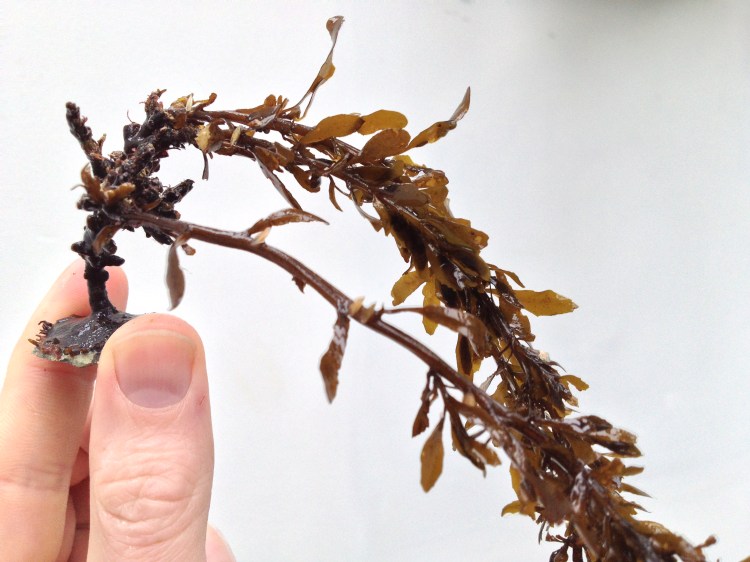
3. Seaweeds can get eaten
Herbivores, such as snails or prawns can start munching on some seaweeds, especially flat greens and reds seemed vulnerable. Perhaps if you provide enough food, they will leave the seaweeds alone (but you risk overfeeding and the disasters that come with that of course). If you are really into your seaweeds, you could also choose to ditch such critters.
new inhabitants
Last weekend I went for a bit of snorkeling off Pendennis Point to catch some new inhabitants of my tank: some Snakelocks anemones and a Leach’s spider crab (just one for a start). Although it was overcast and late, it was nice to be in the water. I was lucky to straight away find a diving knife, this helped me to cut of some kelp housing snakelocks. I took a perforated plastic Lidl bag with me in the water to serve as a net for the crab, low tech but it worked fine. The tricky thing was to get the snakelocks from the kelp afterwards (I did not want a load of rotting kelp pieces in the tank):
With some finicking I could get the anemones off the kelp and on the rocks or gravel. The Leach’s spider crab (decorated with small pieces of red seaweed) quickly hid behind a rock. However, after two days it was accustomed to its new surroundings and found a place underneath one of the anemones right in the front of the tank:
A fresh start
After having the aquarium almost empty over summer, I finally got round to start it up again. I reinstalled the Tunze nanostream, went back from the finer, brown Maerl gravel to normal, coarse gravel and collected some new rocks (slate I think). I looked for these on the middle shore; on the lower shore they are covered with the barnacles and limpets that I do not want and on the high shore they have not yet been eroded by water and have very sharp edges. Still have to get used to the new look. Now on to collect some animals!
animals that did not do that well in my aquarium…
A while back I wrote two posts on my personal top ten animals for the (unchilled) aquarium (here and here). Of course, there were also organisms that were not such a success. Animals can be unsuited for the aquarium for many reasons, and of course this depends on the size of aquarium, the combination of animals and what you define by ‘unsuited’; so please keep in mind that the following is a personal account!
Aggressive species: Another reasons that makes animals unsuitable for a community tank is that they are bullish. (Animals becoming too big is not a real problem for the native aquarium as you can release them again and replace with smaller individuals.) Crabs often get rowdy for instance. I kept a small (5 cm carapace width) Edible crab Cancer pagurus for a little while (his name was Barry). It would bury (Barry!) itself during the day, but as soon as the lights turned off it would go about and rearrange the tank. Rocks weighing over a kilo were knocked against the glass and I found a Cushion star cut in two. It was quite an operation to remove it from the tank using a net (but during all that rummaging I interestingly saw bioluminescence in the tank which was very cool). Shannies like to feed on snails and hermit crabs and so in a relatively small aquarium at least, so sometimes you have to choose between one or the other:
Truly littoral species: I had a couple of limpets Patella vulgata in the aquarium that just sat in the same place on the glass for months. At this time, algal growth was a problem, so I should have known if they had moved during the day or night by the tracks they would have made but they did not move a millimeter. The animals seemed a bit thinner in their shell, but seemingly they can survive for very long periods without food. Not being able to emerge from the water as they do normally seems to be a big problem for these animals.
Secretive species: Other animals simply are too shy or live underneath rocks; no point really in putting them in the aquarium if you cannot see them. This happened with Broad-clawed porcelain crabs, a Shore rockling and also a Shore clingfish (although hidden, all of these animals did survive for a long time). I have seen Brittle stars in a Mediterranean aquarium but the ones found in the intertidal here tend to live under rocks and I never saw one back in the aquarium. A Sand star Astropecten irregularis quickly buried itself in the gravel:
Filter feeders: I quickly realized that filter feeders, mussels or tunicates for example, were very difficult. There simply were not enough algae growing in the water to feed them (unfortunately, at times there were plenty of algae growing on the rocks and on the glass). One way to keep filter feeders is to separately cultivate algae for food. A really nice blog describing such a project can be found here. Another solution might be to feed these animals with artificial plankton, which is available commercially. This requires very good skimming to get rid of excess nutrients though. Both options I find too cumbersome at the moment. Having said all this, one filter feeder managed to survive for many months in my aquarium: the variegated scallop.
Other fussy eaters: Worm pipefish did OK in the aquarium, but that was probably because I regularly brought in new seaweeds housing fresh zooplankton. Unlike Mullet, Gobies or Blennies, I have never seen them take frozen food and therefore I will not keep them again until I can provide them regularly with live brineshrimp or similar. Snakelocks anemones always did well in the aquarium, but Beadlet and Strawberry anemones didn’t (they actually did not die but seem to shrink rather than grow over time). The former are able to grow because of their symbiosis with photosynthesizing algae and so do not rely as much on food. I must say that the latter two species are probably relatively easy to keep when you make the effort to regularly dunk a piece of dead prawn on them. The European cowrie Trivia monacha feeds on tunicates which I had trouble keeping alive and so they are unfortunately not an option yet:
Unknown reasons: On a few occasions a species just died and I had no idea why. The only thing this taught me was to not try that species again. This happened to a Common starfish Asterias rubens:
my Red Sea Max 130D
After moving to the seaside, I was sure that I wanted to have a native marine aquarium but I was not too sure about what set-up to buy. I have quite a bit of experience with tropical fresh water aquariums but marine tanks always seemed to be much more difficult with sumps and skimmers and all that. However, nowadays everyone can start the hobby with a of ‘plug-and-play’ aquarium. After a bit of online research, I decided to go for a Red Sea Max 130D. At 130 liters it is a medium-sized tank, although I guess it is still often classified as a ‘nano’ tank.
All equipment is hidden in a compartment at the back behind black-tinted glass:
 Water flows into the back compartment through a sieve, this sieve cannot be removed for cleaning which is unfortunate as it easily gets clogged, especially when you have lots of seaweeds in the tank (I do not use the extra comb (1) because I did not find it very effective and it takes up too much space). Water then flows through a filter pad (2) into the skimmer compartment (3). The stock RSM skimmer is very noisy and I only use it at night. I find that the skimmer cup is not very easy to clean either. There is an empty compartment (4, 5) for a chiller pump that I hope to fill up soon (of course I do not use the heating element (6)). Water flows then through ceramic (7)- and carbon (8) filter material before two pumps jet the water back into the main tank compartment again (9). This design is quite bad, as the filter material can only be accessed after removing the pumps and the bags are stuck in a narrow compartment. I also use a bag with RowaPhos to remove phosphates to keep algae in check.
Water flows into the back compartment through a sieve, this sieve cannot be removed for cleaning which is unfortunate as it easily gets clogged, especially when you have lots of seaweeds in the tank (I do not use the extra comb (1) because I did not find it very effective and it takes up too much space). Water then flows through a filter pad (2) into the skimmer compartment (3). The stock RSM skimmer is very noisy and I only use it at night. I find that the skimmer cup is not very easy to clean either. There is an empty compartment (4, 5) for a chiller pump that I hope to fill up soon (of course I do not use the heating element (6)). Water flows then through ceramic (7)- and carbon (8) filter material before two pumps jet the water back into the main tank compartment again (9). This design is quite bad, as the filter material can only be accessed after removing the pumps and the bags are stuck in a narrow compartment. I also use a bag with RowaPhos to remove phosphates to keep algae in check.
So filtration, skimming and design could have been designed better (as well as lighting, see a previous post) and it is perhaps no surprise that internet forums abound with descriptions of RSM tank modifications and additions (e.g. this media bag and skimmer replacement option). Although I am overall happy with my Red Sea Max tank, if I would by an aquarium today I probably would assemble it from separately ordered parts.
